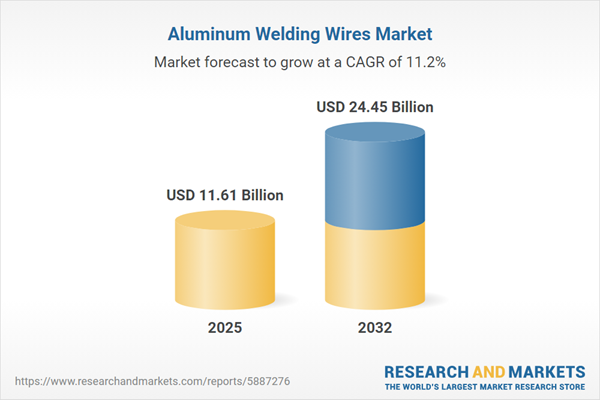Speak directly to the analyst to clarify any post sales queries you may have.
The aluminum welding wires market is progressing through technological innovation and sustainability adoption, underpinned by changing supply chain dynamics. Senior executives are evaluating digital transformation, compliance standards, and value chain resilience as they adapt to ongoing market evolution.
Market Snapshot: Aluminum Welding Wires Market Size and Growth
The global aluminum welding wires market is forecast to expand from USD 10.46 billion in 2024 to USD 11.61 billion in 2025 and reach USD 24.45 billion by 2032, supported by a robust CAGR of 11.19%. This outlook highlights the industry’s enduring relevance for sectors such as aerospace, automotive, marine, and consumer goods. Broader adoption of advanced aluminum alloys for lightweight, high-performance parts is creating opportunities for product innovation and manufacturing efficiency. At the same time, process optimizations and digital tools are accelerating production capabilities, shaping the broader landscape for leading manufacturers and suppliers.
Scope & Segmentation of the Aluminum Welding Wires Market
This report delivers actionable, segment-level analysis covering technological trends, application breadth, and strategic expansion regions, equipping senior leaders with focused insights for precise market assessment and opportunity evaluation.
- Product Form: Flux cored and solid wires, meeting the needs of specialized welding tasks and technical performance criteria across applications from structural assembly to precision manufacturing.
- Welding Process: Gas tungsten arc welding, laser beam welding, and metal inert gas welding, each offering targeted solutions for assembly complexity, production throughput, and specialized joinery requirements.
- End Use Industry: Aerospace, automotive, marine, construction, oil and gas, and consumer goods—demonstrating the versatility of aluminum welding wires and the diversity of manufacturing environments served.
- Alloy Type: Aluminum copper, aluminum magnesium, aluminum manganese, aluminum silicon, and aluminum zinc variants, supporting both conventional and advanced industrial projects with distinct metallurgical features.
- Diameter Range: Multiple sizing options, from sub-0.8 mm to over 1.6 mm, optimize compatibility with a broad spectrum of welding machinery and project scopes.
- Regional Coverage: Americas, EMEA, Asia-Pacific—each with unique regulatory landscapes, growth drivers, and levels of market maturity requiring tailored strategic approaches.
- Companies Profiled: Lincoln Electric Holdings, ESAB Corporation, voestalpine AG, Illinois Tool Works, Air Liquide, Panasonic Corporation, JFE Holdings, Kobe Steel, Shandong Hongniu Welding Materials, and Jasic Technology, exemplifying varied innovation strategies and operational models.
Key Takeaways for Decision-Makers
- Ongoing advances in welding wire technologies and process digitization are propelling higher consistency and quality in manufacturing environments.
- Refined alloy development enables organizations to address emerging application requirements, supplying performance-driven sectors such as aerospace and marine with specialized solutions.
- Adoption of digital systems facilitates predictive maintenance, resource optimization, and seamless throughput, minimizing production downtime and supporting asset longevity.
- Sustainability efforts are increasingly central, with enhancements in recycling systems and cleaner manufacturing supporting organizational compliance objectives and environmental commitments.
- Expanded distribution networks and robust supplier relationships improve operational agility, allowing timely responses to changing global logistics and compliance requirements.
- Executive teams leverage digital platforms to streamline technical support, enhance workforce competencies, and deliver tailored alloy solutions for customer-specific project needs.
Tariff Impact: Navigating Regulatory Realities
New tariff structures, especially in the United States, require companies to rethink sourcing strategies and prioritize investments in higher-value, locally based operations. Leaders are diversifying supplier rosters and fortifying regional supply networks to reduce exposure to global trade disruptions. Regular engagement with logistics and compliance partners ensures stable operations and continual adherence to evolving trade and regulatory standards.
Methodology & Data Sources
The analysis is based on interviews with industry thought leaders in research, production, and procurement, as well as technical benchmarking and sector studies. Regulatory analysis and quantitative models underpin market assessment, while expert review strengthens the credibility and relevance of insights.
Why This Report Matters
- Enables executive leadership to proactively address changes in core technologies, realign supply chains, and remain ahead of evolving regulatory demands in the aluminum welding wires market.
- Supports execution of region-specific strategies and effective adaptation to shifting standards, enhancing competitive resilience and operational sustainability.
- Delivers focused, actionable guidance to drive investment clarity, improve supply chain robustness, and inform long-term strategic planning.
Conclusion
This report guides industry leaders to refine operational strategies, anticipate market shifts, and capture emerging opportunities, establishing a foundation for continued success in the fast-changing aluminum welding wires sector.
Additional Product Information:
- Purchase of this report includes 1 year online access with quarterly updates.
- This report can be updated on request. Please contact our Customer Experience team using the Ask a Question widget on our website.
Table of Contents
3. Executive Summary
4. Market Overview
7. Cumulative Impact of Artificial Intelligence 2025
List of Figures
Samples

LOADING...
Companies Mentioned
The key companies profiled in this Aluminum Welding Wires market report include:- Lincoln Electric Holdings, Inc.
- ESAB Corporation
- voestalpine AG
- Illinois Tool Works Inc.
- Air Liquide S.A.
- Panasonic Corporation
- JFE Holdings, Inc.
- Kobe Steel, Ltd.
- Shandong Hongniu Welding Materials Co., Ltd.
- Jasic Technology Co., Ltd.
Table Information
| Report Attribute | Details |
|---|---|
| No. of Pages | 181 |
| Published | October 2025 |
| Forecast Period | 2025 - 2032 |
| Estimated Market Value ( USD | $ 11.61 Billion |
| Forecasted Market Value ( USD | $ 24.45 Billion |
| Compound Annual Growth Rate | 11.1% |
| Regions Covered | Global |
| No. of Companies Mentioned | 11 |









